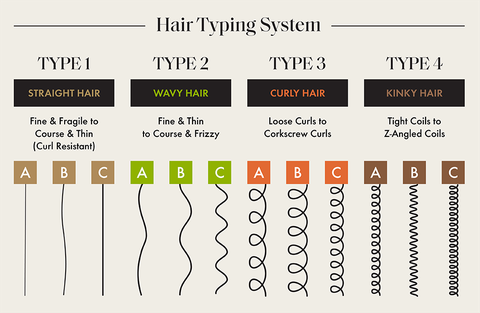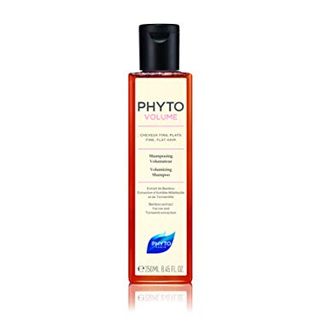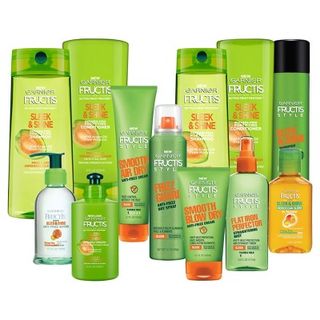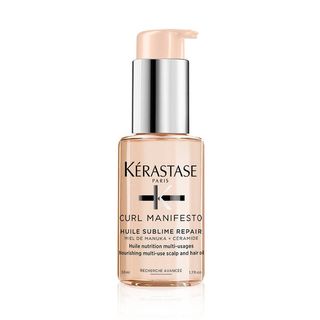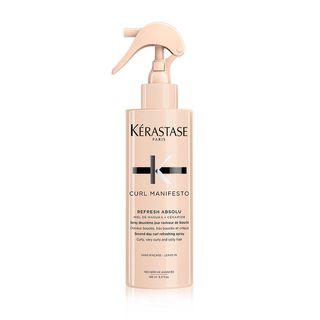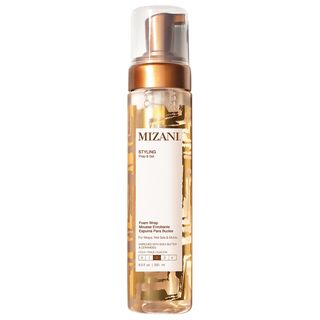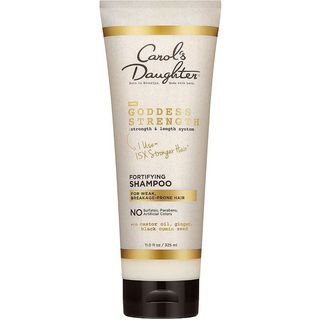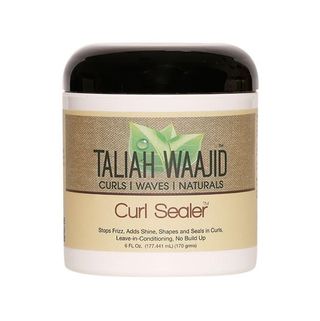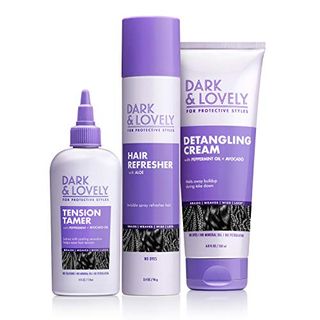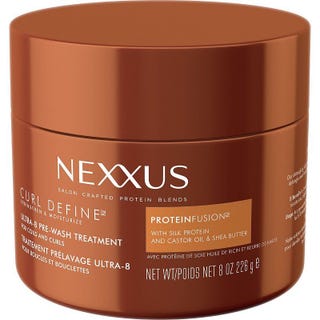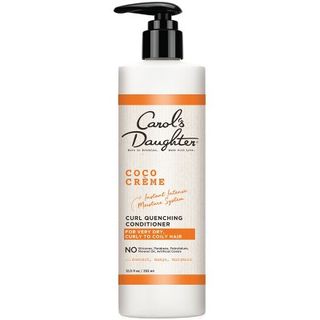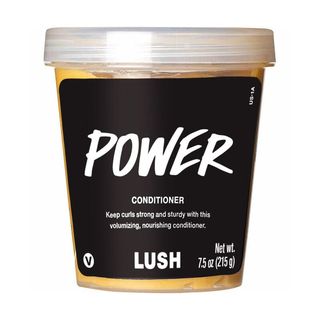Products You May Like
The beauty of curly hair is that it is so versatile. Natural curls come in so many lengths, shapes, and textures. With so much curl diversity within the natural hair community, it can be hard to figure out where you fit—and more specifically, what your curl type is. If you’ve ever found yourself asking “What is my curl type and how do I care for it?” We’ve got expert-level answers.
What Is The Curl Chart?
The hair typing system was conceived by Oprah’s longtime hairstylist Andre Walker. This ingenious way of categorizing our hair from wavy to curly to coily provides informative transparency in determining what products, routines, and techniques work for your hair. The system starts with type 1 hair which is straight and fine and ends with type 4 hair which is coarse with tight coils.
This hair typing chart celebrates the unique differences in every texture. “A lot of us grew up with negative language such as ‘kinky’ and ‘unruly’ as descriptors of our various textures, and now our children have something more truly descriptive and prescriptive,” says Carol’s Daughter founder Lisa Price.
As comprehensive as the hair typing system is, it can still be complicated to navigate. Some people have more than one texture while others have textures that sit on the fence—4B/4C is one of the most common combinations. “It’s tough to say there is a one-size-fits-all prescription for our hair. I encourage women to experiment and see what works best for their hair type. Someone might have 65% 4C and 35% 3B so she will need to use different things. It is okay to play around until you figure out what works for you,” says Price.
We spoke to the most knowledgeable natural hair experts including Vernon François, Kendall Dorsey, and Lacy Redway, who broke down how to find your curl type along with tried and true tips for caring for every curl type from 1A to 4C.
1A is the straightest and thinnest of the curl types. This hair type is usually void of any curls. People with 1A hair can often experience dryness, thinning, and a lack of volume in their strands. “Since Type 1 hair can also tend to have a flatness to it, it is beneficial to use volumizing and texturizing shampoos and conditioners to enhance the shape,” says Celebrity hairstylist Anthony Cristiano.
1B hair is fine in texture but not as flat as 1A hair. This hair type tends to hold a curl better with thicker strands to support the shape. Much like 1A hair, 1B has a similar shine and straightness but is better defined by its volume and body. The last category in type 1 hair is 1C, which is generally smooth, with a thick and resistant texture and a subtle wave.
Garnier Celebrity Hairstylist Millie Morales suggests washing Type 1 hair 2-3 times a week as overwashing can cause dryness and dullness. “Air dry at first and finish by blow-drying with a round brush at a medium heat temperature to help ease the frizz, and opt for products that create softness and hydrate the strands,” says Morales.
Type 2A hair is a dream in versatility; it’s easy to style straight or curly. According to Morales, the pattern of 2A hair forms an S shape and is usually between fine and medium in texture.
2B also takes on an S shape but there is usually more shape and volume from middle downwards. Kérastase’s Global Inclusivity Advisor and Educator, Vernon François—who has worked with names including Willow Smith and Angela Bassett—recommends focusing on product application, particularly conditioner, at the mid-lengths and ends of the hair, using a small amount at the roots. Using a sulfate shampoo is beneficial for all hair types but 2B hair especially, as it moisturizes without weighing the hair down. François recommends the shampoo in Kérastase’s Curl Manifesto range. Another pro tip: “Don’t shy away from using an oil-based treatment on fine strands. A little Curl Manifesto Huile Sublime Repair enhances shine,” says François.
While 2A and 2B strands have an S shape, the shape of 2C curls is most prominent from the scalp to the roots. This results in 2C hair being more voluminous than its 2A and 2B counterparts. The key to getting 2C curls to pop is in the styling. “Gently encourage the spring of the S shape to form when drying and styling hair by compressing and bouncing it using the palm of your handheld flat and facing upwards, in a repeated lifting motion,” says François.
People with Type 2 curls are often looking to control frizz while still maintaining the integrity of the curl. “It’s important to avoid using heavy natural oils that can make this hair type look greasy, or creams and gels that will weigh curls down and make them look crunchy,” says Naturally Drenched founder Jamila Powell.
“No matter what your hair type is, there are some non-negotiables. Curly/Coily hair needs moisture,” says Price.
With curly hair types starting at 3A, using a sulfate-free shampoo and a conditioner with slip is a great way to moisturize and detangle without adding weight to your hair.
Type 3 hair can range from loose but defined curls to tight corkscrews. “You might have this curl type if the diameter of your curls ranges from a piece of chalk to a pencil,” says Powell. Celebrity hairstylist Kendall Dorsey recommends a unique way to approach type 3A hair care: “To maintain a loose curl type like 3A, you can think of your haircare like skincare – prepping, plumping, and hydrating,” says Dorsey. For the prep, Dorsey recommends using a leave-in conditioner or primer from tip to root depending on how much control you are looking for.
“If you are looking to control your wave pattern, use a light gel from tip to root on wet hair, and if you have unruly 3a hair, you can combine all three products: primer, gel, and a cream defining product. Layered these on one-by-one, and air dry for a billowy texture or with a Dyson dryer and diffuser.”
3B hair is springy in a curl pattern with slightly smaller curls than 3A. If your curls are about the width of a Sharpie you’re likely to have 3B hair. For those with this hair type battling frizz is the main focus along with maintaining healthy hydrated curls. Anti-frizz styling products that keep your hair sleek against humidity will be your go-to.
Contrary to the popular narrative type 4 hair is not the hardest texture to care for—it just requires a different kind of TLC. Type 4 hair typically has a tighter curl pattern and is prone to shrinkage. Your texture also will have more fluff and volume, or a zig-zag shape, rather than a loose wave or curl. “Out of all curly types, the 4’s pattern requires the most hydration. This pattern is very delicate and can break easily as the curls can sometimes group and form knots. You have to moisturize continuously, give your strands tons of love with added hot oil and conditioning treatments,” says Unilever Global Hair Care Ambassador and celebrity hairstylist Lacy Redway. Redway has worked with type 4 beauties including Amanda Gorman, Regina King, and Amandla Stenberg. With every type 4 A-lister and model Redway works with, she finds that moisturizing shampoos and conditioners are a must.
4A hair forms an “S” shape pattern with a defined curl definition that is typically soft and displays many small curls closely together. Those with 4A hair typically have a lot of hair, with curls that sit close together and give the appearance of darker strands until stretched. This pattern is usually the easiest out of all type 4 hair to straighten. It may appear to be coarser than it looks or feels to the touch. 4A hair experiences less shrinkage than the other type 4’s—though 4A strands retain moisture well, it can also be the driest of all the type 4’s.
“4A is a very special curl pattern,” says Dorsey. “A finer texture with a higher density of hair, because the texture is fine, it requires moisture and more moisture, because the coils are prone to snap.” For this hair type, Dorsey recommends co-washing, which is using conditioner in place of your shampoo. Using a scrubbing technique while co-washing will also help to release dirt and add hydration to protect the hair.
When styling, use a leave-in conditioner to add slip to help with detangling, along with a hair and scalp oil for shine. “With this texture, I use roping technique to ensure not to break the hair. I like to dry maybe 10-20% with a diffuser to get the moisture out and then air dry the rest of the way for a soft pillowy texture” Dorsey tells ELLE.
If you have 4B hair you typically have a zigzag pattern to your curls. Your curl pattern isn’t very defined naturally and especially when dry, so you will have to do some work to bring out the pattern in your hair. “Because of the different twists and curls this curl pattern forms, the natural oils have a difficult time reaching all parts of your strands, so you will experience dry strands, and your hair could be fluffy in appearance,” says Redway. Products that reinforce moisture and define curls will be your favorite however be mindful to use products that are light in texture and don’t produce build-up. Heavier products like creams and oils should always be used on moisturized hair as these products don’t moisturize the hair but rather seal in moisture.
Last but certainly not least, 4C hair is the tightest of the curly hair types and experiences the most amount of shrinkage. It can resemble 4B but has a higher percentage of breakage (it can break extremely easily) and shrinkage, and also experiences the least amount of curl definition of all 4 hair types. According to Redway, it’s just as difficult to retain natural oils in 4B types as it is with 4C hair because the shape of the curl has many twists and turns, making it difficult for the natural oils the hair produces to reach the hair shafts and ends. Sulfate-free shampoos that hydrate and moisturize will be most beneficial to 4C hair alongside routine deep conditioning.
Protective styles are great for 4C hair to minimize manipulation to the strands and help lock in moisture, and a silk pillowcase is a must to minimize losing natural oils.
This content is created and maintained by a third party, and imported onto this page to help users provide their email addresses. You may be able to find more information about this and similar content at piano.io

